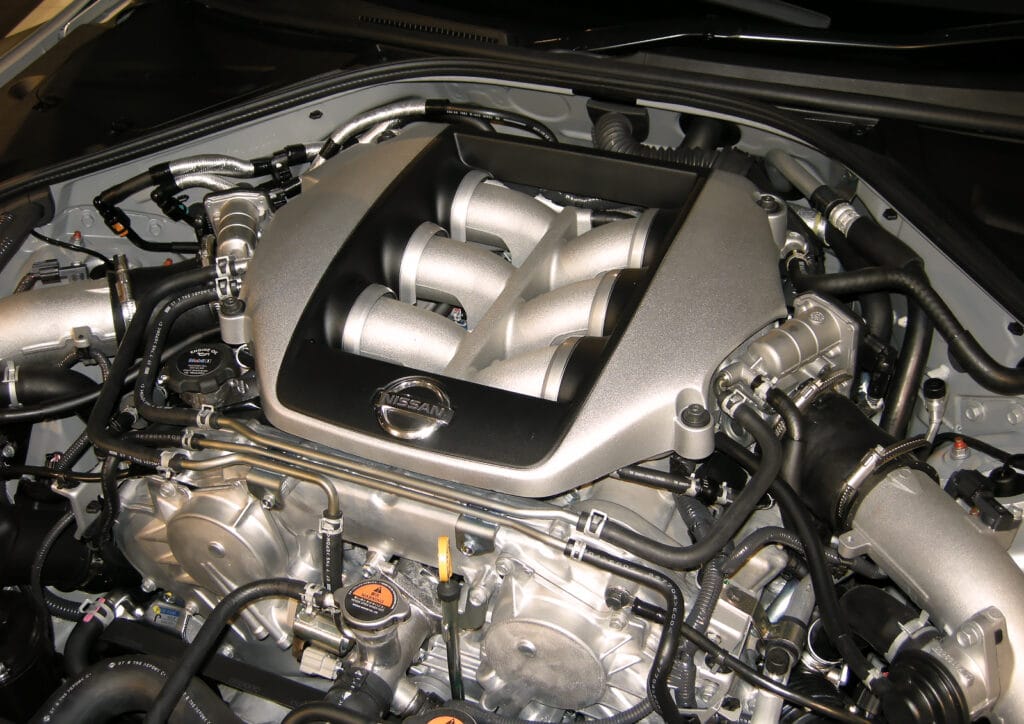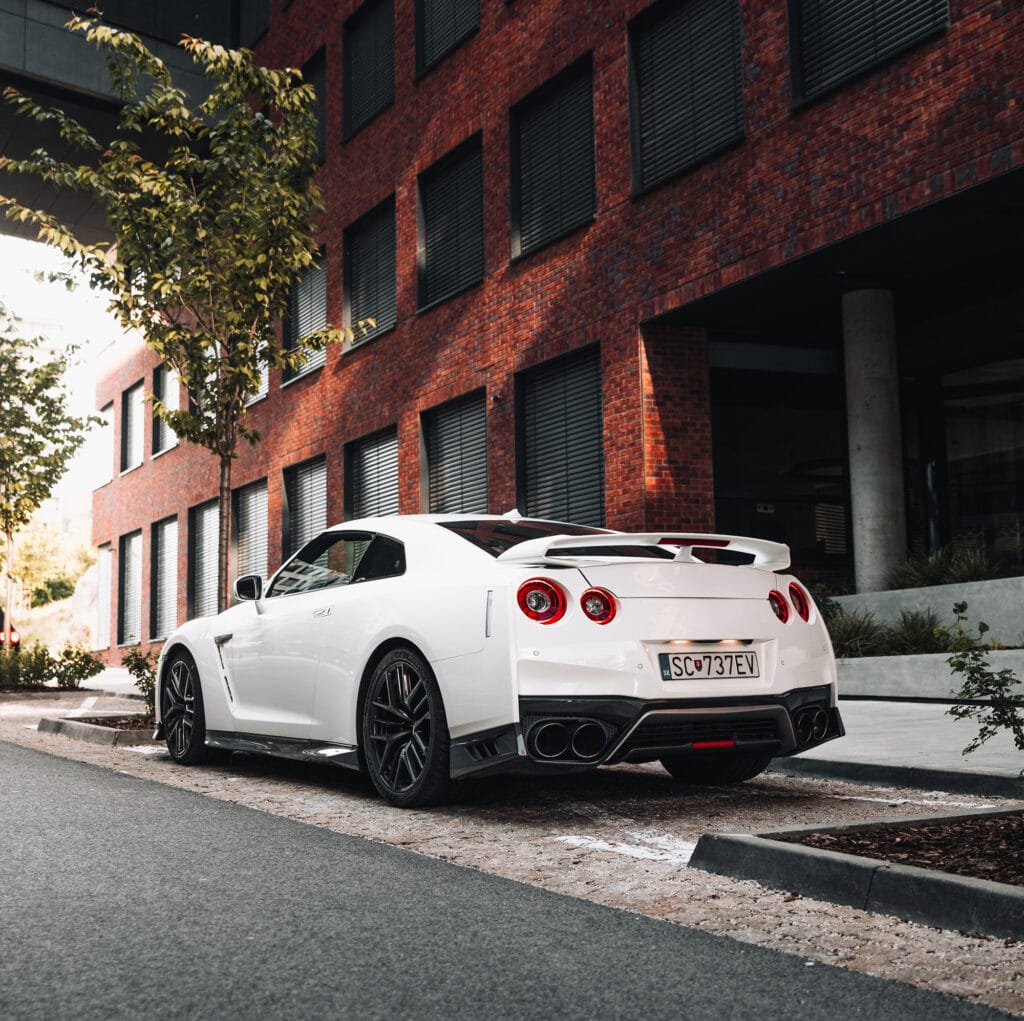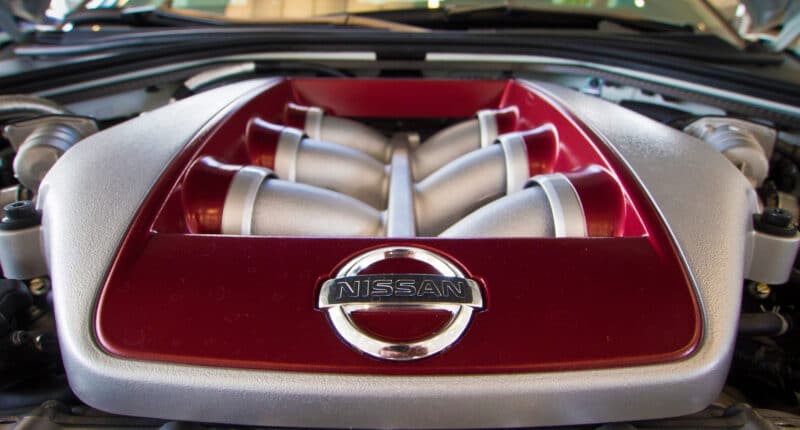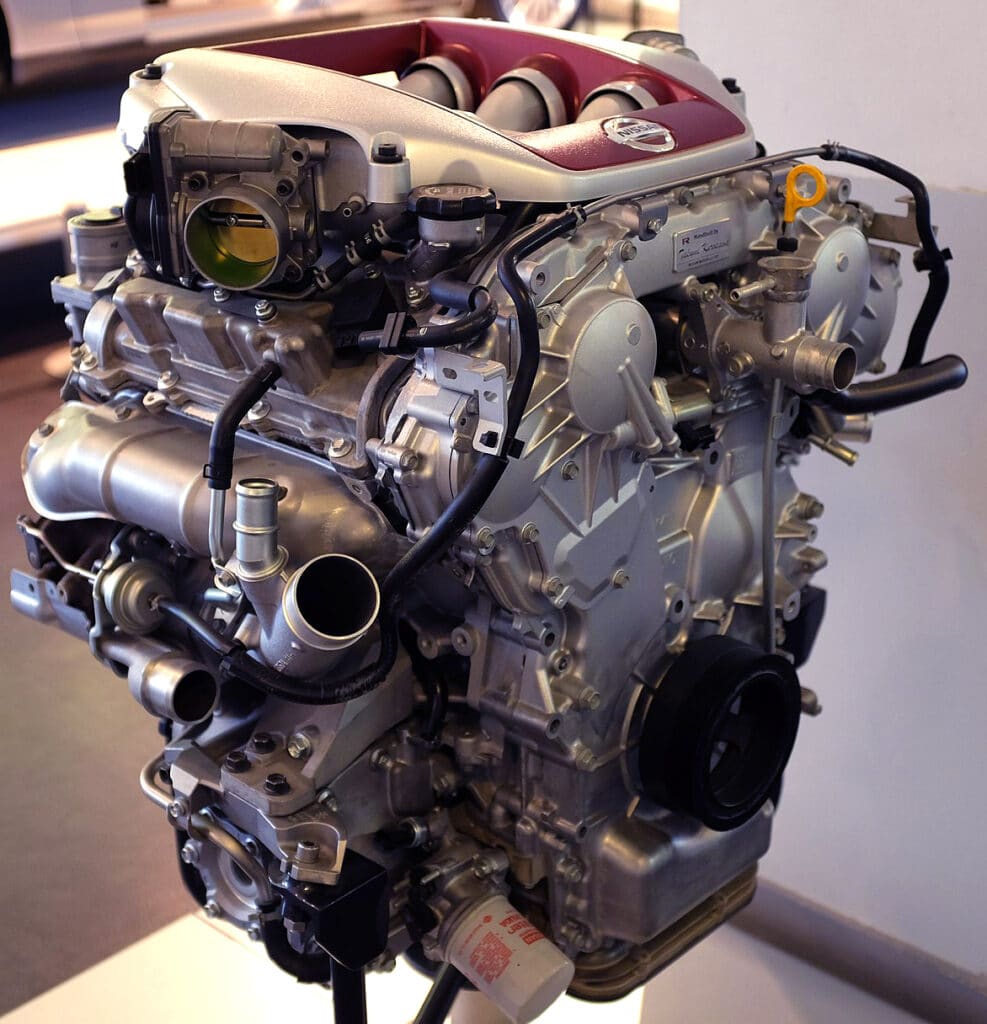The VR38DETT doesn’t have the legendary status of the RB26, but it certainly is worth talking about.
It powers the famous R35 GT-R and is a significant step above its predecessor in terms of engineering quality and output.
Nissan recently announced the retirement of the R35 moniker in Europe, but it will continue to sell in the United States. They aren’t ready to pull the plug on this V6 legend just yet.
A few reasons why the VR38DETT engine is highly regarded:
- It’s immensely overengineered
- It’s extremely tunable, swappable, and sounds glorious
- It’s likely to be the last Takumi-built engine to arrive from Japan. Rumor has it that the next R36 GT-R is going electric.
This article will discuss all things VR38DETT. We’ll briefly touch on its history, specifications, tuning potential, and more.
Nissan VR38DETT: Tech Specs
- Engine Code: VR38DETT
- Layout: Twin-turbo V6 DOHC 24 Valve
- Displacement: 3.8 L (3,799 cc)
- Fuel System: Electronic Multi-point Fuel Injection
- Cylinder Bore: 95.5 mm (3.75 in)
- Piston Stroke: 88.4 mm (3.48 in)
- Compression Ratio: 9:1
- Power: 480 to 600 horsepower at 6,800 rpm
- Torque: 434 to 481 lb-ft at 3,600 rpm
- Firing Order: 1-2-3-4-5-6
In case you didn’t know, the VR38 was specifically designed for the R35 GT-R. However, the engine wasn’t built from scratch. It was based on the tried and true VQ37VHR found in the Nissan 370z and the ever reliable Infiniti G37.
The engine had a lot riding on its shoulders, considering how successful the RB26 (its predecessor) was. Nissan re-engineered the VQ37 extensively, and as a result, a lot of the internals aren’t interchangeable between the two.
Here’s what the engine code represents:
- VR: Engine family
- 38: Displacement (3.8 L)
- D: Dual overhead camshaft (DOHC)
- E: Electronic fuel injection
- TT: Twin turbocharged

Other than having an all-aluminum architecture (including the block and cylinder heads), the VR38 has quite a few innovative features. Both the crankshaft and connecting rods are forged steel and the pistons are cast using the same material.
The cylinder bores have a plasma-sprayed liner to increase their durability, iridium spark plugs for better ignition and lifespan, and continuously variable valve timing (CVTCS) for performance and efficiency.
On top of that, the VR38 also features drive-by-wire throttle, pressurized lubrication with a magnesium oil sump, and a low back pressure exhaust system.
The engine has a cylinder bore of 88.4 mm and a piston stroke of 95.5 mm, all packaged in a 60-degree V-configuration.
In contrast with the RB26DETT, the VR38DETT’s reluctance to be rev-happy can be attributed to its the oversquare design. Displacement is a hair under 3,800 cc, and the VR38 makes use of IHI RHF55 twin turbos boosted to 13 psi.
All VR38 engines are hand-built by one of four specially trained “Takumi Craftsmen” at Nissan’s Yokohama plant. Also, each engine has a plaque with the name and initials of the master technician, making it rather unique.
Though the VR38DETT was intended for the R35 GT-R, the engine can also be seen in the limited-run Nissan Juke-R.
Nissan VR38DETT: Power Figures and Variants
The R35 GT-R was sold in several different variants and trim levels since its inception in 2007. Despite being more than a decade old, the VR38DETT motor continued receiving several power upgrades from Nissan.
Initially, it made 480 horsepower and 430 lb-ft of torque. This increased to 530 hp and 448 lb-ft in the 2012 model, courtesy of new intake and exhaust manifolds and increased boost pressure of 0.9 bars.

The subsequent model year got a bump in power as it increased to 545 hp, and torque was also pushed to 463 lb-ft. It also got new, more efficient fuel nozzles, redeveloped headers, and a re-mapped ECU.
The next major power bump came with the GT-R’s 2017 refresh. With a new ignition system, titanium exhaust manifolds, and higher boost pressure. Power figures saw an incremental jump to 565 hp and 467 lb-ft.
All GT-R model years since have the same power and torque figures from their VR38DETT motor. The 2015+ GT-R Nismo variants got the same powerplant, although output was rated at 600 hp and 481 lb-ft.
Swap Ideas and Tuning Potential
Sourcing a VR38 is an expensive. But that hasn’t stopped enthusiasts from experimenting.
This motor has been swapped into countless engine bays — from the Toyota Hiace to S15 Silvias, there are some ludicrously powerful VR38 builds around the globe.
Remember the Nissan Patrol that annihilated the Porsche 918 hypercar? It had an insanely done-up VR38 under the hood.
Another example is a 4.1L VR38 stroker engine swapped into a Toyota GT86. Perhaps even more astonishing is a Toyota Hiace with a VR38 powering it.

If money is no object, then yes, by all means, get the VR38DETT. But if you’re looking for a cheaper alternative, then the better option is to source a VQ35.
For R35 GT-R owners looking for a serious bump in power, it is possible to safely get up to 600 hp with a few mods.
But, if you’re going beyond 600, consider upgrading the engine internals. Forged pistons, titanium rods, bigger turbos, upgraded intercoolers, bigger injectors, and cams for instance. There’s a lot you can upgrade.
However, it all rather depends on how much you’re trying to push the VR38. We’ve seen extreme examples of GT-Rs with 3000 whp, running six-second quarter miles! And that’s power at the wheels, not at the crank.
Check out our bhp vs hp vs whp guide for more information on that subject.
Reliability
Overall, Nissan’s VR38 is an impressively reliable engine. There really aren’t any common issues that plague the engine itself. Of course, with age and mileage, problems are bound to occur at some point. Routine maintenance should take care of that.
That said, look out for general problems like the engine running lean/rich, misfire, and knocking.

The majority of the problems that do occur in the VR38 are due to bad tuning.
The VR38’s bad rep for longevity can be attributed to bad tuning and overambitious boost figures. Conservative tuning, quality internals, proper maintenance, and decent driving habits are the recipe for reliability.
These upgrades don’t come cheap. So make sure you have enough saved up when looking at modding your VR38 motor. When done right, these handbuilt engines can be exceptionally dependable.
Final Note

The VR38 is an incredibly complex piece of engineering. Unlike the RB26, this engine is part of an era where electronics control a vast majority of functions.
As a result, many R35 owners find that it lacks the analog feel GT-Rs from the yesteryears. But that doesn’t make the engine any less exciting.
The amount of shove available from the motor and how it balances with the electronics and chassis of the GT-R is unbelievable.
The way we see it, the VR38DETT is quite an exotic motor. It’s not as bulletproof as the 2JZ-GTE, nor as high-revving as the RB26DETT. But it’s hand built, lighter, and far more sophisticated in terms of fuel delivery, ignition timing, and power output.
Is it worth the premium it demands? Not if you can’t afford it. The VQ35DE or VQ37HR cost about half as much as a VR38, and there is plenty of aftermarket support for the VQ.
Feature image: Nan Palmero, Nissan R35 GT-R Engine, CC BY 2.0



1 comment
Bore Spacing?
Cylinder Wall Thickness?